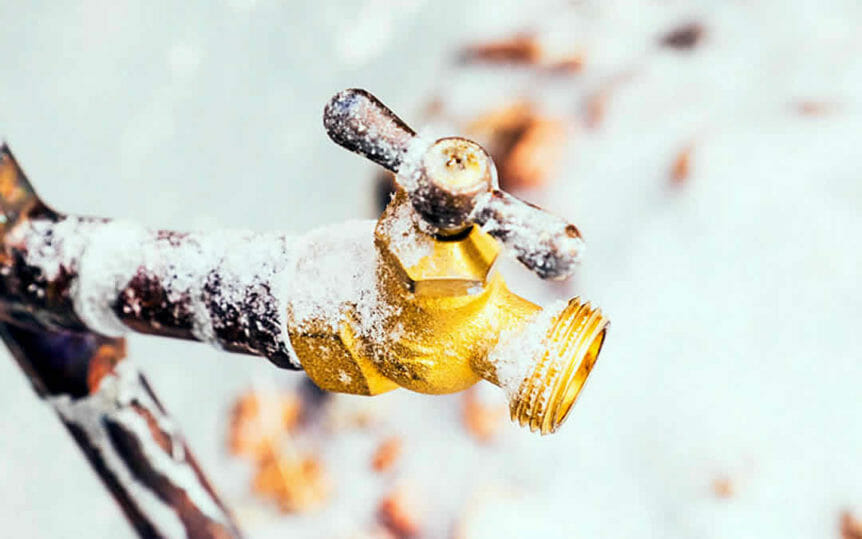
Protecting Your Plumbing From Freezing Weather
It’s that time again Houston — winter is here in full force! With temperatures below freezing at night, some urgent around-the-home maintenance is needed (did you see the segment on KTRK about what to do?) to make sure our pipes stay insulated and don’t freeze up! Because who wants to wake up in the morning with no running water? We sure don’t!
“Wind and cold air are what freeze pipes, and by properly covering up all exposed pipes from the wind you are taking the right steps to make sure your pipes don’t freeze up and burst,” said John Moore Services Manager and Master Plumber Joe Bany. “Protecting pipes from the wind is key. The wind chill is colder than the outside temperature and when it reaches a certain degree, it can destroy all unprotected piping.”
Protect Your Home Before You Freeze
Wrap up all pipes and hose bibs outside that are exposed: All pipes, hose bibs, and sprinklers that are exposed to the outside elements are vulnerable to freeze if not properly wrapped AND insulated. Many people wrap a towel or newspaper around an exposed pipe thinking that it will be enough to keep it from freezing, but this is not the case.
“Using a towel to protect an outdoor pipe is a horrible idea because towels and newspapers hold moisture,” said Bany. “Basically it is like covering your pipe with a wet rag, and that only increases the freezing process. There are materials that are made specifically for pipe covering that should be used instead.”
The best item to use that will cover and insulate outdoor fixtures is polyethylene foam insulation. It is a foam wrap that will completely cover the exposed pipe and protect it from rain, wind, water, and cold air. Different sizes are available and they can be purchased at your local hardware store.
Fix all outdoor leaks: Many times, homeowners have a leaky hose bib and do not notice it or get it fixed because it is hidden away in the backyard. Now is the time to inspect and repair all leaks, yes, even the small ones. If we get cold weather, the leaking water will freeze all the way up the hose bib and get back into the pipe. The tiniest leak can cause a great amount of damage.
Make sure you have the right amount of attic insulation: Attic insulation isn’t just for keeping our home cool during the summer; it also helps to keep warm air inside during the winter, which can be beneficial during a freeze. Pipes, along with other important systems in the home, are located in the attic. If your home is not equipped with the right amount of insulation, your pipes might freeze.
What if my pipes DO freeze?
Start thawing!
There are various options you can try to thaw your frozen pipe. Here are some common solutions:
- Hair Dryer: Possibly the quickest, easiest, and safest methods for thawing a frozen pipe, a hair dryer can access hard-to-reach pipes underneath your sink and in a number of other areas throughout your house. A high-powered hair dryer can provide concentrated heat specific sections of your pipe, helping you to thaw it quickly.
- Heated Blankets / Heating Pads: Applying a moderate amount of heat directly to the pipe can help quickly and safely melt the ice. Just be sure to be careful with the cord and with any electricity used near the pipe. You definitely don’t want to add fire or electrocution to the excitement of the day. For a safer alternative, soak washcloths in hot water, and apply those instead. Just rinse and repeat to continue melting the blockage.
- Heat Lamp: Providing both light and heat, a heat lamp can be used to concentrate warming effects onto the frozen pipe. It can also be useful in tighter spots.
Warning: if there is standing water anywhere near the burst pipe, use extreme caution with any electrical appliances. Keep kids and pets away from the scene until the pipe is un-frozen and the area cleaned up.
And do not under any circumstance use an open flame of any sort, which can cause explosions, fires, and other calamities.
“The last thing you want to do to a frozen pipe is to use a torch to try and warm it up,” said Bany. “When you use a torch on a pipe that is already frozen you can create stress problems and cause the pipe to crack. Once they freeze the right thing to do is to wait it out. You never want to be aggressive with your plumbing because you will create bigger problems.”
If your pipes do freeze, the most important thing to remember is to call a plumber after they have thawed to come inspect the damage. Having a licensed technician thoroughly inspect your whole piping system to make sure the freeze didn’t cause any leaks is important and can save you from experiencing further damage. And John Moore Services has trained plumbers ready and waiting to help. Give us a call!
